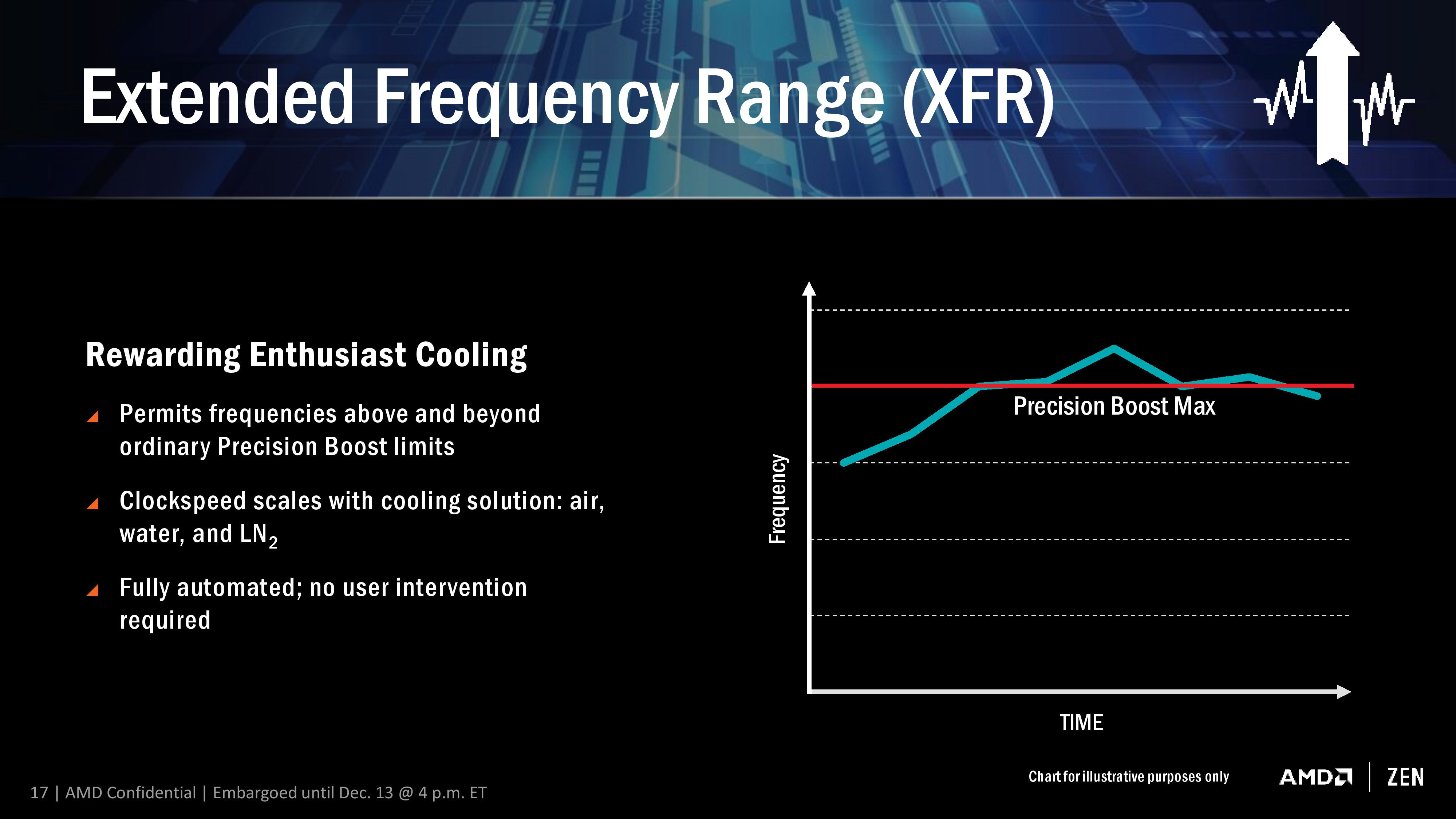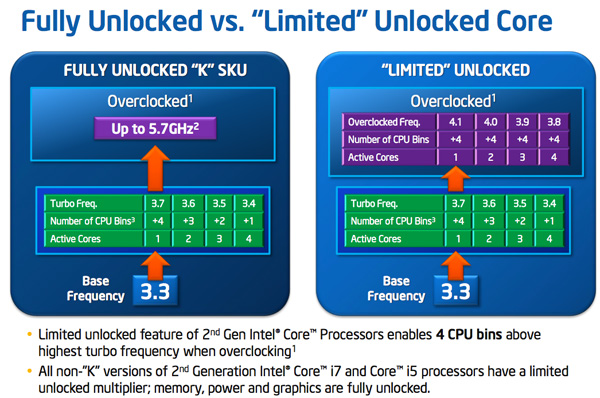lolfail9001
Golden Member
- Sep 9, 2016
- 1,056
- 353
- 96
Literally extended frequency range: ability to set arbitrary multipler above some arbitrary value.What exactly is it that you think XFR means or does?
Literally extended frequency range: ability to set arbitrary multipler above some arbitrary value.What exactly is it that you think XFR means or does?

No, if you interpret them by the letter, they are true about Intel's unlocked multiplier as well. Graph is a trickier subject, but if we assume it actually thermal throttles like that, then it's still all fine.If that's the case, you'd have to believe that this slide is a complete fabrication:
i7-3820 had unlocked multiplier.... but that unlocked multiplier was capped at 42. Get my comparison yet?The only way your explanation makes sense is if its just a fancy marketing term for unlocked chip, in which case all Ryzen CPUs have XFR since AMD has already said they'll be unlocked and you can manually OC assuming the motherboard supports it.
i7-3820 had unlocked multiplier.... but that unlocked multiplier was capped at 42. Get my comparison yet?
Of course, this is the absolutely worst case scenario for what XFR is.

No, if you interpret them by the letter, they are true about Intel's unlocked multiplier as well. Graph is a trickier subject, but if we assume it actually thermal throttles like that, then it's still all fine.
i7-3820 had unlocked multiplier.... but that unlocked multiplier was capped at 42. Get my comparison yet?
Of course, this is the absolutely worst case scenario for what XFR is.
AMD already has that with Precision boost and their GPUs: what it translates to is automated throttling based on temperature/power draw.state an automated solution that scales based on cooling solution used.
Intel sells a ton of chips that automatically throttle on power draw caps and have turbo clocks so inflated, lifting the limits on them serves no purpose whatsoever. Matter of fact, so does AMD. And yes, clocks scale automatically.Yes, you can do all of that manually, but Intel doesn't sell any chips that will automatically do it for you.
Fabrication? Nah, more like spin. The looncraz/bjt's descriptions combined paint a much more coherent picture, so i stick to it now.The only reason to believe XFR works the way you suggest is because the slide is a fabrication.
Fabrication? Nah, more like spin. The looncraz/bjt's descriptions combined paint a much more coherent picture, so i stick to it now.
If it was really smart, and boosted the cores I wanted, then I would leave it alone. For instance, if I am playing WoW, and it only boosts those 2 cores higher than I could boost all the cores, then that would be great.It sounds to me like XFR only effects the regular boost function, making it boost higher. If that's the case, most overclockers won't care about it because it won't effect all cores. Most people will end up overclocking on all cores anyway. Business as usual in the overclocking area is what I expect.
I'm also a little worried about the apparent lack of PCI-E lanes. So what if I decide to go SLI? I'm stuck with 8X on each GPU? Maybe less than that?
If it was really smart, and boosted the cores I wanted, then I would leave it alone. For instance, if I am playing WoW, and it only boosts those 2 cores higher than I could boost all the cores, then that would be great.
Each card would be 8x PCI-E gen 3 slots, and you won't notice a difference on current gen vid cards.I'm also a little worried about the apparent lack of PCI-E lanes. So what if I decide to go SLI? I'm stuck with 8X on each GPU? Maybe less than that?
Exactly, the difference would be negligible even on a pair of Titan X cards.Each card would be 8x PCI-E gen 3 slots, and you won't notice a difference on current gen vid cards.
That's basically what i said i use as current working hypothesis. Except that i do not expect it to push any far, because not at a single point AMD specified whether XFR will work off of default TDP rating or something specific. In which case all it relies on is keeping temperature so low that it actually affects power consumption in meaningful way.What XFR supposedly does is detect that the CPU is running cool and automatically exceed the predefined boost limits.
But effectively it would produce same result as putting 4.8Ghz turbo clock on mobile Intel CPU. Or Carrizo CPU.So no, it's not something that Intel has
That's one thing oc.net have empirically established: on pair of Titan XMs or XPs, it does make a difference on minimums.Exactly, the difference would be negligible even on a pair of Titan X cards.
Exactly, the difference would be negligible even on a pair of Titan X cards.
Your interpretation is wrong and your conclusion is wrong, here are the chips sets.
http://hothardware.com/ContentImage...summary.jpg.ashx?maxwidth=1170&maxheight=1170
its disk IO is 4 SATA off the chipset + 4PCIE gen 3 broken up into whatever the MB maker wants it to be.
Majord covered it here:
http://i.imgur.com/Luc2HEW.png
Rumour is that Zen doesn't clock that high anyway, like getting above 4.0Ghz is difficult. So, XFR might not really matter that much.
Might have to wait for Zen 2.0 for CPUs that can match Intel's clocking capabilities.
Based on? I have never seen anything about that.Rumour is that Zen doesn't clock that high anyway, like getting above 4.0Ghz is difficult. So, XFR might not really matter that much.
Might have to wait for Zen 2.0 for CPUs that can match Intel's clocking capabilities.
Rumour is that Zen doesn't clock that high anyway, like getting above 4.0Ghz is difficult. So, XFR might not really matter that much.
Might have to wait for Zen 2.0 for CPUs that can match Intel's clocking capabilities.
Zen has already 4.0 GHz default turbo clock. I don't think that at 4.025GHz suddenly it will explode. Actually with XFR it should surpass 4GHz quite well even at default.Rumour is that Zen doesn't clock that high anyway, like getting above 4.0Ghz is difficult. So, XFR might not really matter that much.
Might have to wait for Zen 2.0 for CPUs that can match Intel's clocking capabilities.
My understanding is the Sata E ports on the chipset can only be 2x SATAe or PCIe v3, but that shouldn't stop a MB making use of those 4x PCI-E3 lanes to go to a chip that has lots o SATA/whatever, or they could use the PCI-e 2.0 lanes to do that if they wanted.Can you elaborate on that? As far as I read the diagram, if I choose a B350 board I can get for example a 4xNVMe port (m.2) directly to the SOC and then the chipset offers 2xSATA3. Can the SATA-e ports also be used as normal SATA3 ports? (If mobo maker decides to do that?). If not number of sata ports are pretty low. I mean you need 1 for a bluray drive and 1 for a hdd at least. I currently have 3 HDDs...
Well, Broadwell sort of does exactly that, but at 4.2->4.3 jump instead.I don't think that at 4.025GHz suddenly it will explode.
So far we have seen only hints of 100mhz over stock boost.Actually with XFR it should surpass 4GHz quite well even at default.
Broadwell starts from 400MHz of base clock lower and with an higher TDP. If we shift the Broadwell behaviour (even ignoring the TDP differences) by 400MHz, probabily we are not so far from reality of Zen OC behaviour...Well, Broadwell sort of does exactly that, but at 4.2->4.3 jump instead.
So far we have seen only hints of 100mhz over stock boost.
You know enough about CPUs to understand that Broadwell WILL have higher TDP. Disable 256-bit AVX and look at tdp then. Going to bet it will be 95W too, with Turbo clock too, making the clocks between 1800X and 6900k virtually identical.Broadwell starts from 400MHz of base clock lower and with an higher TDP.
So, 4.2Ghz it is?If we shift the Broadwell behaviour (even ignoring the TDP differences) by 400MHz, probabily we are not so far from reality of Zen OC behaviour...


